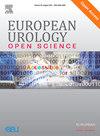Alterations in DNA Damage Repair Genes Before and After Neoadjuvant Cisplatin-based Chemotherapy in Muscle-invasive Bladder Cancer
IF 3.2
3区 医学
Q1 UROLOGY & NEPHROLOGY
引用次数: 0
Abstract
Background and objective
The role of genetic variants in response to systemic therapy in muscle-invasive bladder cancer (MIBC) is still elusive. We assessed variations in genes involved in DNA damage repair (DDR) before and after cisplatin-based neoadjuvant chemotherapy (NAC) and correlation of alteration patterns with DNA damage and response to therapy.
Methods
Matched tissue from 46 patients with MIBC was investigated via Ion Torrent–based next-generation sequencing using a self-designed panel of 30 DDR genes. Phosphorylation of γ-histone 2A.X (H2AX) was analyzed via immunohistochemistry to evaluate DNA damage. Genetic variants were analyzed along with clinical data and quantitative phospho-H2AX data using the Kaplan-Meier method, Cox regression analysis, and factor analysis of mixed data.
Key findings and limitations
Twenty-five patients (54%) had a response (<pT2 pN0 cM0) to NAC. Responders had more somatic DDR gene variants in preNAC (53 vs 11; p < 0.001) and postNAC (51 vs 9; p = 0.038) tumor tissue in comparison to nonresponders, as well as significantly greater phosphorylation of H2AX after NAC. ERCC2 was significantly co-mutated with REV3L among responders. Owing to the small cohort, no specific mutation was significantly positively associated with therapy response. However, accumulation of CDK12, NBN, MSH3, MLH1, ATR, BRCA1, BRCA2, REVL3L, and SLX4 variants was observed for responders.
Conclusions and clinical implications
Patients with MIBC who responded to cisplatin-based NAC had more somatic DDR gene variants than nonresponders. Moreover, responders exhibited significantly greater DNA damage after NAC.
Patient summary
Patients with muscle-invasive bladder cancer who have mutations in genes that are involved in repair of DNA damage are more likely to respond to cisplatin-based chemotherapy. Testing to identify these gene mutations could help in selecting the patients who are most likely to benefit from this treatment.
肌肉浸润性膀胱癌新辅助顺铂化疗前后DNA损伤修复基因的改变
背景与目的:基因变异在肌肉浸润性膀胱癌(MIBC)全身治疗应答中的作用尚不明确。我们评估了以顺铂为基础的新辅助化疗(NAC)前后参与DNA损伤修复(DDR)的基因变异,以及改变模式与DNA损伤和治疗反应的相关性。方法:采用自行设计的30个DDR基因面板,采用基于离子激流的新一代测序技术对46例MIBC患者的匹配组织进行研究。γ-组蛋白2A磷酸化。通过免疫组化分析X (H2AX)来评估DNA损伤。采用Kaplan-Meier法、Cox回归分析和混合数据的因子分析,结合临床资料和磷- h2ax定量数据对遗传变异进行分析。主要发现和局限性:与无应答者相比,25名患者(54%)的肿瘤组织有应答(p p = 0.038), NAC后H2AX的磷酸化显著增加。应答者中ERCC2与REV3L显著共突变。由于队列小,没有特定的突变与治疗反应显著正相关。然而,在应答者中观察到CDK12、NBN、MSH3、MLH1、ATR、BRCA1、BRCA2、REVL3L和SLX4变异的积累。结论和临床意义:对基于顺铂的NAC有反应的MIBC患者比无反应的患者有更多的体细胞DDR基因变异。此外,反应者在NAC后表现出更大的DNA损伤。患者总结:参与DNA损伤修复的基因突变的肌肉浸润性膀胱癌患者更有可能对以顺铂为基础的化疗有反应。检测这些基因突变可以帮助选择最有可能从这种治疗中受益的患者。
本文章由计算机程序翻译,如有差异,请以英文原文为准。
求助全文
约1分钟内获得全文
求助全文
来源期刊

European Urology Open Science
UROLOGY & NEPHROLOGY-
CiteScore
3.40
自引率
4.00%
发文量
1183
审稿时长
49 days
 求助内容:
求助内容: 应助结果提醒方式:
应助结果提醒方式:


